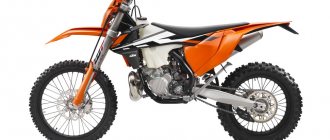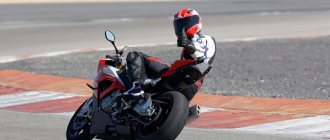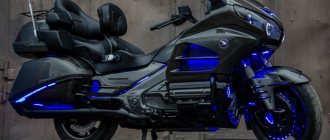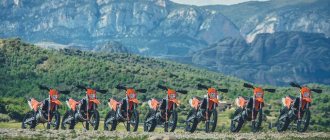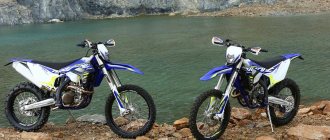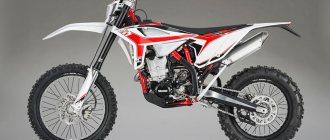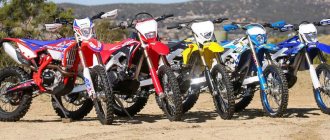The entire line of KTM motocross motorcycles has been completely redesigned for the 2021 model year, with changes affecting the engine, suspension and chassis.
The new generation motorcycles received a more rigid frame, but at the same time lost some of the comfort. The suspension settings were not very good for the new, stiffer chassis. For the 2021 model year, KTM engineers spent a lot of time refining the suspension. They also added power to the engine with a new air cleaner housing cover. We hit the motocross track to test the 2021 KTM 350 SX-F.
Technical characteristics of ktm 350 exc f
| Engine volume, cm3 | 349,7 |
| Power, hp | 36 |
| Number of cylinders | 1 |
| Number of cycles | 4 |
| Maximum speed, km/h | 160 |
| Gasoline consumption, l | |
| Tank volume, l | 5,5 |
| Transmission | 5-speed |
| Seat height (without load), mm | 915 |
| Weight, kg | 107,2 |
The powerful single-cylinder engine allows you to maximize the potential of the SUV on rough terrain. The cooling system is liquid. The fluid circulates using a pump. Electronic ignition is used. The engine is started using an electric starter and a kick starter. Fuel is supplied by an injector. The manufacturer recommends using AI-95 gasoline.
A 6-speed manual transmission is installed, which is distinguished by reliability and smooth operation. A multi-plate hydraulic clutch is used. The frame is lightweight and reliable, as it is made of chrome-molybdenum pipes. The suspension is fully consistent with the purpose of the motorcycle. Front suspension: adjustable telescopic fork. The rear suspension is a pendulum with a monoshock absorber. The degree of shock absorber stiffness can be adjusted.
The KTM EX 350 hydraulic disc brake system responds sensitively to every press of the lever. The front brake is equipped with a 4-piston caliper, the rear with a 2-piston caliper.
2021 KTM 350 SX-F Suspension
KTM's efforts on the WP Xact suspension are noticeable and commendable. I've noticed that the bike is now much easier to customize to suit my ability and riding style. I set the sag a little higher than recommended to improve cornering grip and compensate for front wheel sensitivity that was too much for me. I also raised the fork in the traverses from the second to the third line to load the front wheel more. After a few laps I felt the front end of the bike was sitting too low, so I increased the air pressure from 10.4 bar to 10.7 bar and increased the compression force by three clicks. This helped with front end control when braking, and didn't ruin the bike's cornering performance. After riding it some more, I slowed down the rebound force by two clicks front and rear.
Disadvantages of the model
- High price and cost of replacement parts.
- Low mounted steering wheel. A person taller than 185 cm will find it uncomfortable to reach the steering wheel when standing. Eliminated with stands under the steering wheel.
Reviews of the ktm 350 sxf are mostly positive. The high price is justified by the quality, reliability and durability of the motorcycle, as well as its technical characteristics. Due to its relatively light weight, the motorcycle is distinguished by its simplicity, maneuverability and controllability. It is very often used for traveling through the mountains and performing various tricks. The lightweight frame and durable, reliable suspension allow the bike to be used as rigidly as possible.
Engine KTM 350 SX-F 2021
There are no changes to the KTM 350 SX-F's engine, but it feels like it runs more efficiently than the 2021 model. This is likely due to the new suspension settings and the new air filter housing cover with holes.
It is quite difficult to describe the character of this engine. When riding, you should keep the revs a little higher than the 450cc engine. see, but its character is not similar to the 250F. There's plenty of power and if you're in the right gear, you won't need to use the clutch very often. The KTM 350 SX-F doesn't have the 450's punch to correct all your mistakes, but the engine isn't as unforgiving if you go too hard on the throttle in a flat corner. Mid-range power is excellent and builds right up to the rev limiter. This engine loves the mid to high rev range.
KTM 350 SX-F on the motocross track
It took a few laps to understand the character of this engine. I've been riding the 450 for the past few weeks and have been upshifting too early and it's causing me to lack power in the corners. When I changed the timing of the gear shift, the ride became more natural.
I would call the KTM 350 SX-F engine the fastest 250F in the world.
If you love the power character of 250F engines, this is the bike for you. If you're used to driving at lower revs, you may be disappointed.
KTM 350 SX-F
Of the two available maps, I used map no. 2, which is always my choice on KTM motorcycles. It increases torque compared to map No. 1, which is clearly noticeable when driving in third gear. The traction control is good, but it takes a few laps to understand how it works. I drove a few laps with the system activated and didn't notice any interference, so I turned it off. After two laps it became obvious to me that this system really helps with the bike's control in corners. With the system turned off, the rear wheel lost traction several times in corners where I had previously had no problems.
The adjustable throttle grip and air filter housing cover with extra vents are noticeable upgrades for the serious racer. The throttle makes it possible to reduce the stroke length, which will be convenient for some. The optional air cleaner housing cover with larger openings changes the character of the KTM 350 SX-F engine more noticeably than on the 450 SX-F. It increases power throughout the entire rev range.
The gear ratios on the KTM 350 SX-F are good. It took me a few laps to get used to the engine's powerband and learn to select the right gears.
It was sometimes difficult to upshift under load, especially uphill. I had to let off the gas more than I wanted, or use the clutch harder than I expected, or sometimes both. During a race, if you are riding next to another racer or hanging on their tail, this can give your opponent a slight advantage.
KTM 350SX-F VS. HUSQVARNA FC350: FULL TEST
When it comes to 350 vs 450 motocross racing, there are two camps. One believes that the 350 is a huge advantage for the average rider, that the advantages in handling and the confidence it gives the rider are more than enough to make up for any lack of raw power. The other camp consists of those who have never tried a 350.
In the MX world, the entire 350 class comes down to just these two bikes - the KTM 350SX-F and the Husqvarna FC350.
Riders keep lining up for the 450s because that's what the big boys ride. For professional racers and the relatively small group of racers who are on the edge of being so strong, so talented and so fast, the 450 makes sense. For average riders who are older, weaker and less talented, the 350 is pure magic. Why are there only two 350cc motocross bikes to choose from? Some people even say there is only one. The KTM 350SX-F and Husqvarna FC350 are the only entrants, and they come from the same factory. We have never considered ourselves among those who say that Husqvarna is just a white KTM. This is like saying that identical twins are the same person. To us, the bike has an identity that goes well beyond the part number list, making the KTM and Husqvarna compelling comparisons.
The parent company views Husqvarna as a premium brand and sets the price a little higher.
WHAT ARE THE DIFFERENCES?
We view Husqvarna and KTM as two separate entities and treat them as such in all of our shootouts. However, since KTM's acquisition of Husqvarna in 2013, the two brands have always finished in our 250 and 450 shootouts. They may feel very different on the track, but the differences are not enough to create a big performance advantage. Here are the differences that matter:
- body:
Both motorcycles received new plastic for 2021. - Seat Cover:
The Husky is more grippy and has a slightly different shape. - Airbox:
Husqvarna has a composite polyamide airbox with different airflow characteristics. - Handlebars:
KTM has Neken; Husqvarna has Rental. - clutch:
KTM has Brembo hydraulics; Husqvarna has Magura. - Rim:
KTM has Takasago Excels; Husqvarna has Dirty Stars. - Cosmetics:
KTM has silver spokes and engine cases; Huskies have black knitting needles and gold covers. - Weight:
The Husqvarna is 1/2 pound heavier on our scale, mainly due to the airbox. Oddly enough, they both round up to the same figure - 222 pounds. - Mystery Ingredient:
We always felt the difference in the suspension valves, but every time we looked, we were wrong. We still believe what we believe. - No different:
Some Husqvarna models have Magura brakes, but not this one. Some Husqvarna models have different mufflers than the KTM, but not this one. - Price:
The Husqvarna is $100 more expensive at $9,799 versus $9,699.
Is KTM faster? Most riders say it feels faster and more responsive than the Husqvarna.
NEW FOR 2019
Both bikes have undergone a significant number of changes this year. They aren't exactly "brand new" but they do look completely different. The chassis changes were carried over from the 2019 KTM SX-F 450 and Husky FC450, which in turn were the same as the changes that the KTM Factory Edition and Husqvarna Rockstar Edition received before the start of the 2021 racing season. These changes are based on a new frame that is considered stiffer in each plane. The swingarm has a longer chain adjustment slot, which the factory team apparently uses to fine-tune performance in testing. Both KTM and Husqvarna received new bodywork, although they were different from each other. The radiators are installed 12 mm lower. 350 engines finally get the DDS clutch and diaphragm spring that have been used on two-stroke engines for 450 years or more. The head is lighter and the exhaust is new. You no longer have to remove the shock before removing the tube thanks to the sliding fit in the middle.
CASE FOR 350
The goal here is not to dissuade riders from their 450s. There are quite a few riders who are brave and strong and can really use the extra power. And there are others who don't care about power. They just don't want to move. These guys are at each end of the bell curve. For big mid-corner hump riders, the 350 is the best bike. You should know upfront that the 350 is no lighter than the current 450 from KTM and Husqvarna. They weigh exactly the same - 222 pounds without fuel on our scale. You should also know that the 350 doesn't make much less power. At peak it produces about 3 horsepower. Most Dynamos put 350s at about 54 horsepower, while a good 450 is 57.
The reason mere mortals can ride a 350 so much better comes down to one thing: confidence. The bike may not be lighter, but it feels lighter. It may not be slower, but in the rev range where you spend most of your life, it feels slower. Both of these facts make you feel like you can master the bike rather than being mastered by it. On a 450 you tend to underestimate the bike. It's just a lot easier to stroll around at 4000 rpm than to tempt fate by pumping the throttle harder. On the 350 you can't do that. In order for the bike to move, you have
roar it. And the more you use it, the more fun you will have. And since the gyroscopic effect is much smaller, 350 turns with much less effort. Again, this has nothing to do with weight, but the perception of weight at 450 can slow you down.
The biggest technical differences between Husqvarna and KTM come down to different components.
On the track, however, the two bikes have distinct personalities. Which 350?
As we said, in every shootout, regardless of class, Husqvarna and KTM finished close. You just can't split this many parts and expect a lot of separation. But when you compare just these two bikes, small changes seem big. The biggest difference between the 350s is power. The KTM is more aggressive and sharp, and it actually feels faster. It is wrong to call any motorcycle "rigid". Both have incredibly smooth power delivery and very wide powerbands. The trick to riding one of these is staying on it. As you keep revving the bike higher and higher, the power increases. The operating RPM range is much wider than most racers realize.
We can explain the difference in power by pointing to the box. We have no explanation for the differences in treatment. KTM has a heavier interface. It changes the way you ride a bike. On a Husky you have to go further forward to bite the front wheel. This makes it a little more demanding to ride. We made sure that all suspension settings were the same, but all riders agreed that there was a clear difference. Perhaps the body and the bend of the steering wheel position the driver differently, or perhaps there really are differences in the suspension. Is this a big deal? No. At the end of the day, the KTM 350SX-F and Husqvarna FC350 are not identical bikes, but there are more similarities than differences. Two different personalities don't offer many advantages or disadvantages on the track. This brings us back to what we said earlier: brand identity is not just part numbers. Racing programs, dealerships and heritage all come together to determine whether you identify with a brand. The first step in this case is to recognize that you are in the middle of the bell curve and that a value of 350 makes sense.
Is 350 better than 450? Many racers think so.
2021 KTM 350 SX-F Chassis and Handling
With my setup, the 350 SX-F was the best cornering KTM I've ever ridden. It doesn't corner as easily as I'd like, but if you get on the bike and spend a little more time tweaking, it can be managed. The KTM 350 SX-F weighs a little more compared to the 250F due to the larger engine, so it takes some getting used to. However, it feels significantly lighter than the 450.
The riding position on the KTM 350 SX-F is comfortable, with the flat seat making it easier to move forward when entering corners. The Brembo front brake provides good initial stopping power, but is not progressive enough when stopping from high speeds with a heavy load. After a long, high-speed stretch in fourth gear through a tight 90-degree corner, I would have liked a little more stopping power from the front brake. The rear brake is excellent and makes stopping power easy to control - the 220mm rear disc doesn't lock up the wheel as quickly as on some competing bikes.
The more I rode the KTM 350 SX-F, the better I felt on it. Our test bike was brand new - we started the test with two hours on the meter. The frame and triple clamps actually felt stiff with increased stiffness, but I think that feeling should lessen as the bike gets more mileage. It would be interesting to do a comparison at 15-20 hours to see if the bike feels softer and by how much.
